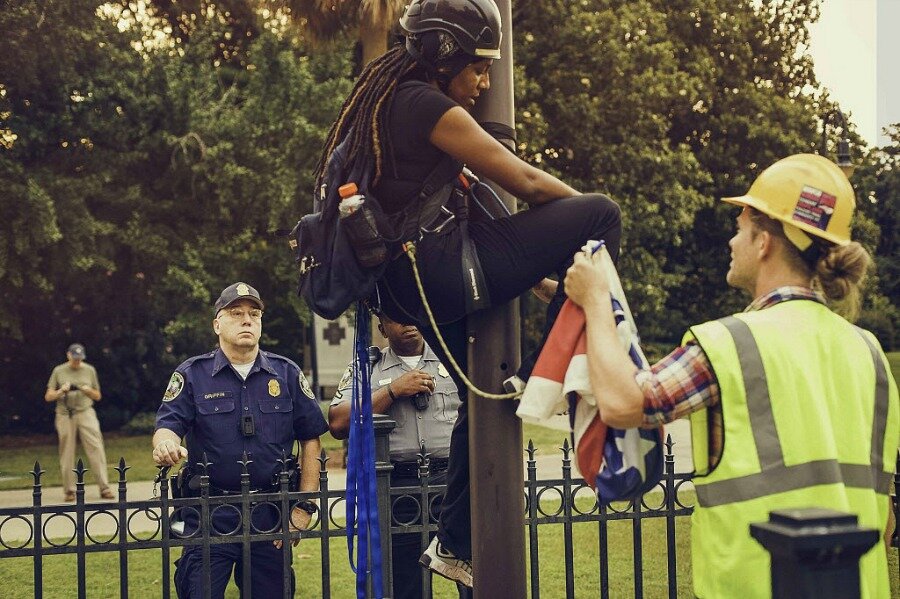Confederate flag removed in South Carolina: Anarchy or moral protest?
Loading...
| ATLANTA
The “Southern cross” Confederate battle flag was briefly taken down early Saturday morning from its perch in Columbia, S.C., not by official decree, but by civil rights activist Bree Newsome, who scaled a 30-foot flagpole near the state capitol to grab the flag. Authorities met Ms. Newsome on the ground, arrested her, and replaced the flag within an hour.
The trespass at a gated and locked Confederate memorial on the state grounds came after a week of heated national debate about Confederate symbols, which included a growing list of vandalism of Confederate monuments.
Since a white supremacist killed nine African-Americans during a Bible study in Charleston, S.C., last week, the phrase “Black Lives Matter” has been scrawled on Confederate monuments from St. Louis to Columbia, vandalism that conflates the symbolic remnants of white supremacy flown by admitted killer Dylann Roof with a series of police killings involving unarmed black men that began nearly a year ago.
The flag-pole scaling protest on Saturday morning also came a day after President Obama, speaking at the funeral of Rev. Clementa Pinckney, one of those killed by Mr. Roof at a historic black church last week, called for states to remove the flag from taxpayer-supported state grounds, calling it “a reminder of systemic oppression and racial subjugation.”
Republican lawmakers in South Carolina and elsewhere have also begun to make overtures toward removing the same flag that Newsome removed Saturday morning.
Obama’s call to take down the flag was intended as an appeal to legislative reason. But activists like Ms. Newsome have taken such calls literally, breaking the law in the process.
To be sure, the comingling of America’s policing debate and that of Confederate symbols seems an awkward one to critics, given, they say, that the acts of a sole white supremacist hardly reflects on Southern heritage more broadly, and certainly not on police who risked their lives to catch the admitted killer.
But Elizabeth Brondolo, a psychology professor at St. John's University in New York who studies the effects of race on mental and physical health, told the Associated Press that the defacing of memorials reflects a "consensus that there's been a very serious failure of empathy, a failure to understand what these symbols might mean to people who suffered from slavery and ongoing aggression."
Others say the acts are understandable in the context of a long-running cultural battle between the post-civil rights era and the desire by many Southerners, especially, to remember the honor of past Confederates rather than the white supremacy Confederate symbols represent to many Americans today.
Monuments that have been defaced include ones in Charleston, Baltimore, Austin, Texas, Asheville, N.C., and at the Confederate Memorial in St. Louis' Forest Park.
The acts are an aggressive jab that come at the end of a week where America has been forced to face its most hidden prejudices in open and real ways. At the end of a remarkable week that saw unity of faith and purpose in the wake of the Charleston massacre, President Obama, the first black president, arguably found his true voice when he, in a deep bass, intoned “Amazing Grace,” the soul-stirring hymn that has become, in full, an American anthem.
The episodes of vandalism, in some ways, represent small skirmishes on a national battlefield raging with emotion about the meaning of the Confederacy and its symbolic hold on the New South.
To some, the vandalism suggests logic run amok.
“I’m getting the impression that [activists who deface monuments] are claiming that Roof is a symptom of something deeper … that he’s only one member of some vast army of hate-filled, white race warriors who are planning executions,” writes Jazz Shaw, on the conservative Hot Air blog. The blogger then points to Roof’s own manifesto, where Roof bemoans how he seems “alone” in his quest to start a race war.
Clyde Johnson, the dean of intercultural development at Maryland Institute College of Art, told the Baltimore Sun that even vandalism with a “positive message … isn’t good.”
But some civil rights activists disagree.
“For hundreds of years, black folks in the South and across the country have had to sit around and watch the type of symbols that represent the very worst of America being flown in their faces,” says Rashad Robinson, director of ColorofChange.org, the nation’s largest online civil rights organization, in a Monitor interview.
Mr. Robinson applauded Newsome’s personal activism on Saturday, noting that such acts are “fueled by a participation age where people have the ability to not wait for a single leader to tell them what to do next. There’s a new kind of power that people have to connect to the outrage and make their voices heard.”








